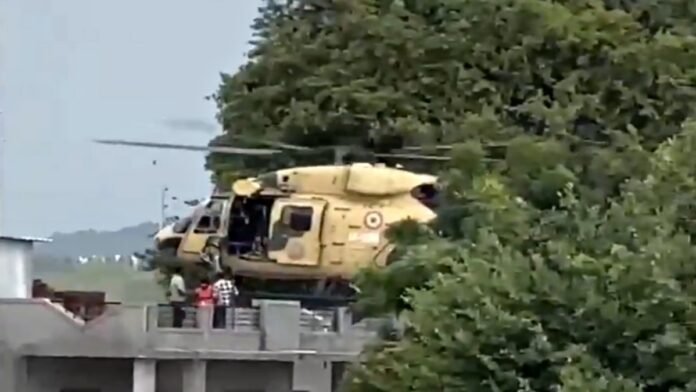
Key Points
- 44 people trapped in floodwaters in Ashti taluka, Beed district; 5 more stranded in Sillod taluka of Chhatrapati Sambhajinagar
- Army and NDRF deployed for large-scale rescue operations as rivers and canals overflow across Marathwada region
- Emergency helicopter rescue requested from Nashik for aerial evacuations from worst-hit villages
- Five villages in Ashti taluka completely cut off: Kada, Sobha Nimgaon, Ghata Pimpri, Pimperkhed, and Dhanora
- Percolation tank breach at Chinchkhandi in Ambajogai taluka complicates rescue efforts
- Deputy CM Ajit Pawar personally monitoring situation; 37mm rainfall recorded in Beed in 24 hours till Monday morning
- Viral social media videos show severity of flooding as essential services disrupted across rural communities
Mumbai: Marathwada region faced its worst flooding crisis in recent months as torrential overnight rains transformed normally dry riverbeds into raging torrents, trapping dozens of residents and forcing emergency deployments of central and state rescue forces. The situation escalated rapidly during the early hours of Monday, September 15, 2025, catching many rural communities unprepared for the sudden water surge.
The crisis has exposed the vulnerability of Marathwada’s drought-prone region to extreme weather events, with the same areas that regularly face water scarcity now grappling with devastating floods. Emergency response teams are working against time as weather forecasts predict continued rainfall over the next 48 hours.
Beed District Bears Brunt of Flooding
Ashti Taluka Crisis Deepens
Beed district has emerged as the epicenter of the flooding crisis, with Ashti taluka reporting the highest number of trapped civilians. The 44 people stranded across five villages represent families who were caught off-guard by rapidly rising water levels that submerged approach roads and cut off all ground transportation links.
Kada village has been particularly affected, with entire neighborhoods inundated and residents forced to seek shelter on rooftops and upper floors of buildings. Local sources report that the village’s primary health center and school have been completely submerged, forcing evacuation of patients and disrupting educational activities.
Sobha Nimgaon, historically known for its water conservation efforts, ironically faces the worst flooding in decades. The village’s check dams and water harvesting structures, designed to store monsoon water, have overflowed dramatically, creating an unprecedented crisis for the agricultural community.
Infrastructure Collapse Compounds Crisis
The breach of the percolation tank at Chinchkhandi in Ambajogai taluka has emerged as a critical complication in rescue operations. This infrastructure failure has released additional water volumes into already swollen drainage systems, creating secondary flooding in previously safe areas.
Engineering teams are assessing the extent of the breach while rescue operations continue simultaneously. The tank’s collapse has raised concerns about the structural integrity of similar water storage facilities across the region, prompting immediate inspections of other critical infrastructure.
Chhatrapati Sambhajinagar Affected Areas
Sillod Taluka Emergency
Five residents of Mauje Deulgaon Bazaar in Sillod taluka of Chhatrapati Sambhajinagar district find themselves surrounded by rapidly rising floodwaters. The situation here differs from Beed’s widespread village flooding, with the emergency concentrated in a specific locality where drainage systems proved inadequate for the overnight rainfall intensity.
Local fire brigade and disaster response teams have established a forward base near the affected area, but rising water levels have prevented ground-based rescue attempts. The stranded individuals are reportedly safe but require immediate evacuation as their temporary shelter locations become increasingly precarious.
Multi-Agency Rescue Operations
Army and NDRF Deployment
The Indian Army’s rapid deployment reflects the severity of the situation, with specialized flood rescue teams arriving from nearby cantonments within hours of the emergency declaration. Army personnel are utilizing inflatable boats and all-terrain vehicles to navigate flooded areas where conventional rescue vehicles cannot operate.
The National Disaster Response Force (NDRF) has deployed multiple teams equipped with specialized water rescue equipment, including motorized rafts and underwater breathing apparatus for potential submersion rescues. NDRF officials report that their teams are prioritizing elderly residents and families with young children for immediate evacuation.
Aerial Rescue Coordination
The request for helicopter assistance from Nashik represents an escalation in rescue efforts, acknowledging that ground-based operations alone cannot reach all stranded individuals within safe timeframes. The Maharashtra government has approved the deployment of Indian Air Force helicopters for aerial reconnaissance and emergency evacuations.
Helicopter operations face challenges due to low visibility caused by continued rainfall and cloud cover, limiting rescue windows to brief periods of improved weather conditions. Pilots are coordinating with ground teams to identify safe landing zones near affected villages.
Official Response and Monitoring
Deputy CM’s Direct Involvement
Deputy Chief Minister Ajit Pawar’s personal monitoring of the situation reflects the political significance of the crisis in Marathwada, a region that has historically faced agricultural distress and water scarcity issues. His office has established direct communication channels with district collectors and rescue coordinators to ensure rapid decision-making.
Pawar has authorized emergency funds for immediate relief operations and directed the deployment of additional state disaster response teams. His involvement also signals the government’s recognition that the flooding could impact upcoming agricultural activities crucial for the region’s drought-recovery efforts.
Administrative Response Mechanisms
District administrations in both Beed and Chhatrapati Sambhajinagar have activated their disaster management protocols, establishing control rooms with 24-hour staffing to coordinate rescue operations and provide real-time updates to state headquarters.
Revenue officials are conducting rapid assessments of crop damage and infrastructure impact to facilitate immediate compensation processes. Preliminary reports suggest significant damage to standing crops, particularly in areas where harvesting was scheduled to begin within days.
Meteorological Context and Rainfall Data
Unprecedented Rainfall Intensity
The 37mm rainfall recorded in Beed within 24 hours represents an unusual concentration of precipitation for the region, particularly given the timing in mid-September when monsoon activity typically begins to recede. Meteorological analysis indicates that the rainfall intensity exceeded the region’s drainage capacity by significant margins.
Weather stations across Marathwada recorded varying rainfall amounts, with some locations receiving over 50mm in shorter timeframes, creating localized flash flood conditions that overwhelmed natural and artificial drainage systems.
Climate Pattern Analysis
The flooding event reflects broader changes in monsoon patterns affecting Maharashtra, with increasingly erratic rainfall distribution creating extreme weather events in traditionally drought-prone areas. Agricultural experts express concern about farmers’ ability to adapt to such unpredictable weather variations.
The timing of the floods, occurring during the crucial post-monsoon period when farmers assess crop yields and plan harvest activities, poses additional challenges for the region’s agricultural recovery from previous drought conditions.
Social Media Documentation and Public Awareness
Viral Video Evidence
Videos circulating on social media platforms provide stark documentation of the flooding’s severity, showing submerged houses, stranded livestock, and desperate rescue attempts by local residents. These images have galvanized public attention and prompted additional volunteer rescue efforts from nearby districts.
The social media documentation has also aided official rescue efforts by providing real-time location information and helping identify areas requiring immediate attention. However, authorities have cautioned against unauthorized rescue attempts by untrained volunteers.
Community Response and Solidarity
Local communities not directly affected by flooding have mobilized to provide support, with neighboring villages offering temporary shelter and essential supplies. This grassroots response demonstrates the region’s resilience despite facing recurring natural disasters.
Religious and social organizations have established temporary relief centers, providing food, clothing, and basic medical care for evacuated families. These community efforts supplement official relief operations and provide crucial support during the emergency response phase.
Long-term Implications and Recovery Planning
Infrastructure Resilience Assessment
The flooding crisis has exposed critical gaps in Marathwada’s flood preparedness infrastructure, particularly in areas that have historically focused on drought mitigation rather than flood management. Engineers are conducting rapid assessments to identify immediate repair needs and long-term infrastructure improvements.
The percolation tank breach highlights the need for comprehensive structural assessments of water storage facilities across the region, many of which were constructed decades ago without considering extreme weather event scenarios.
Agricultural Impact and Recovery
The flooding’s impact on standing crops and stored grain could significantly affect farmers already struggling with irregular rainfall patterns and market fluctuations. Agricultural officials are documenting crop losses to facilitate insurance claims and government compensation processes.
The immediate priority involves preventing waterlogged fields from developing fungal infections that could destroy remaining crops, requiring rapid drainage efforts once floodwaters recede and weather conditions permit field access.





















































